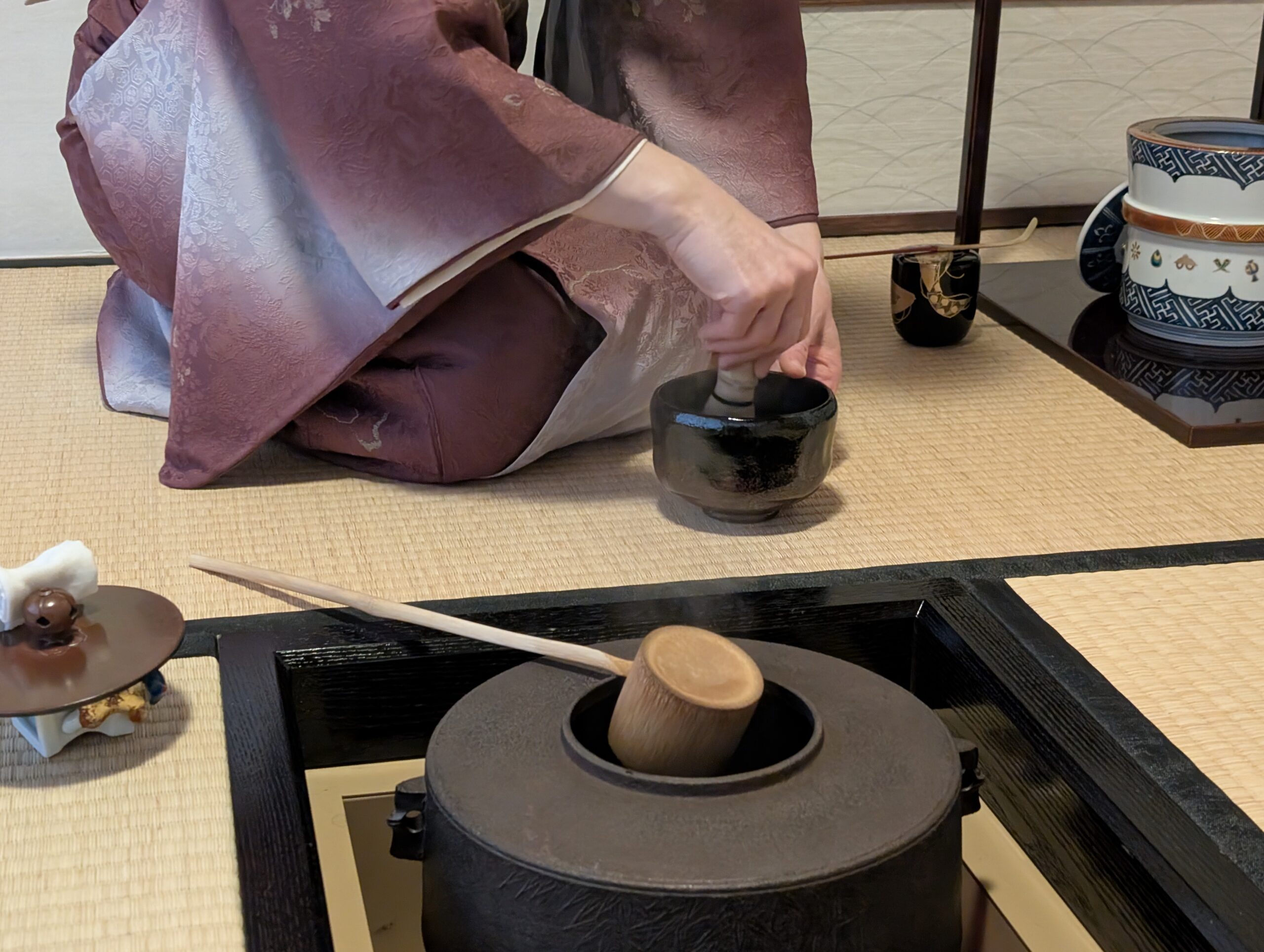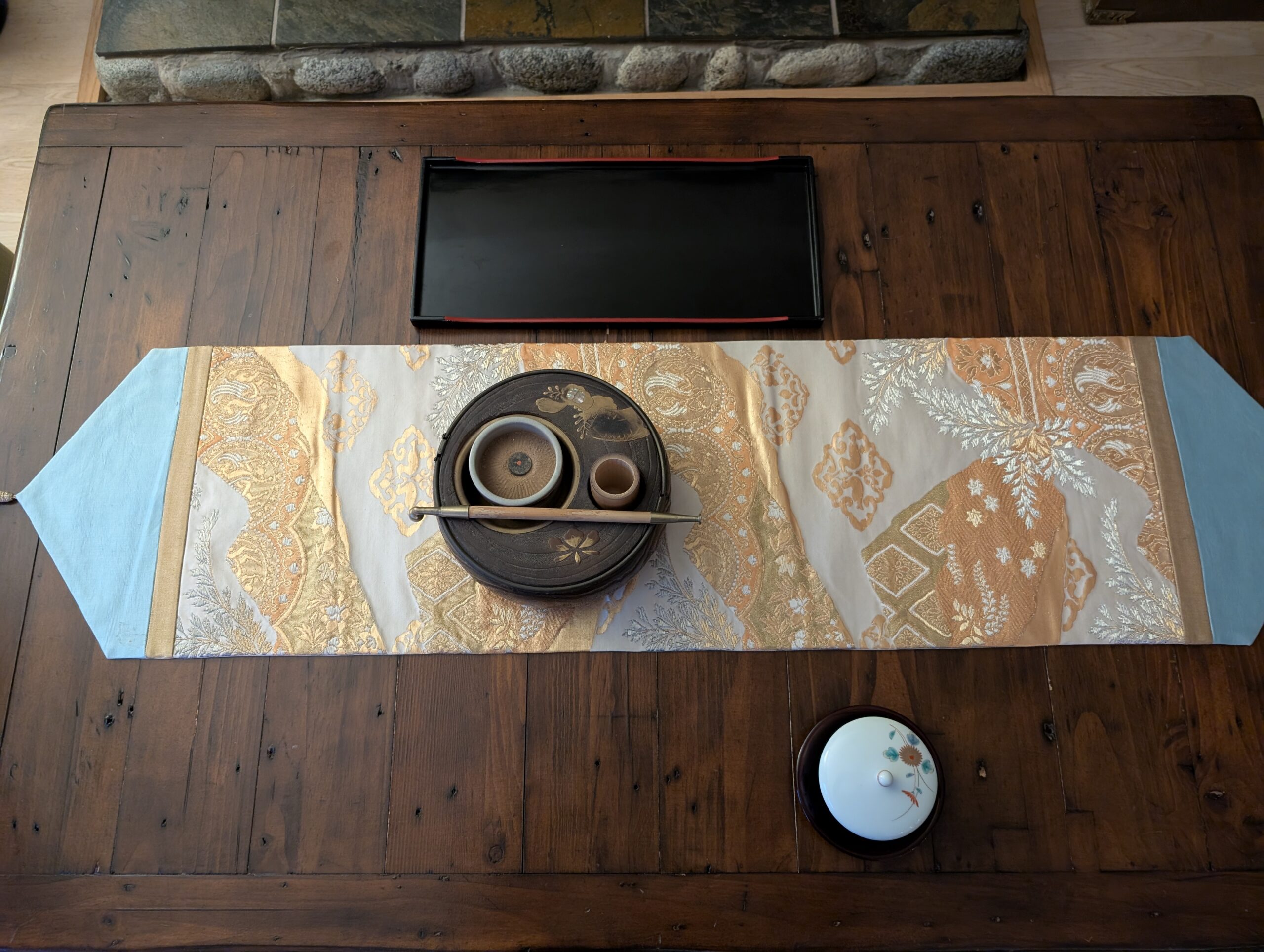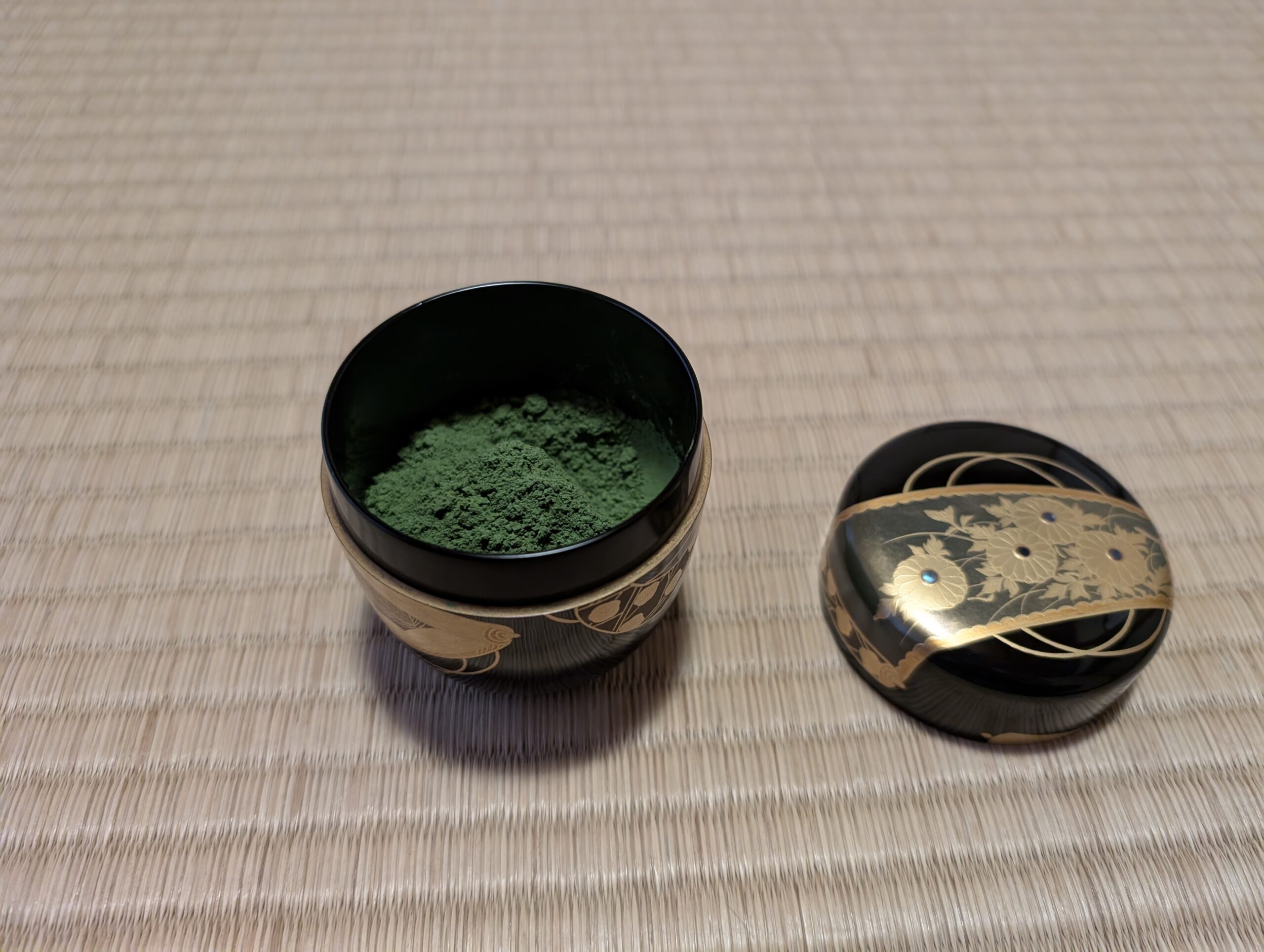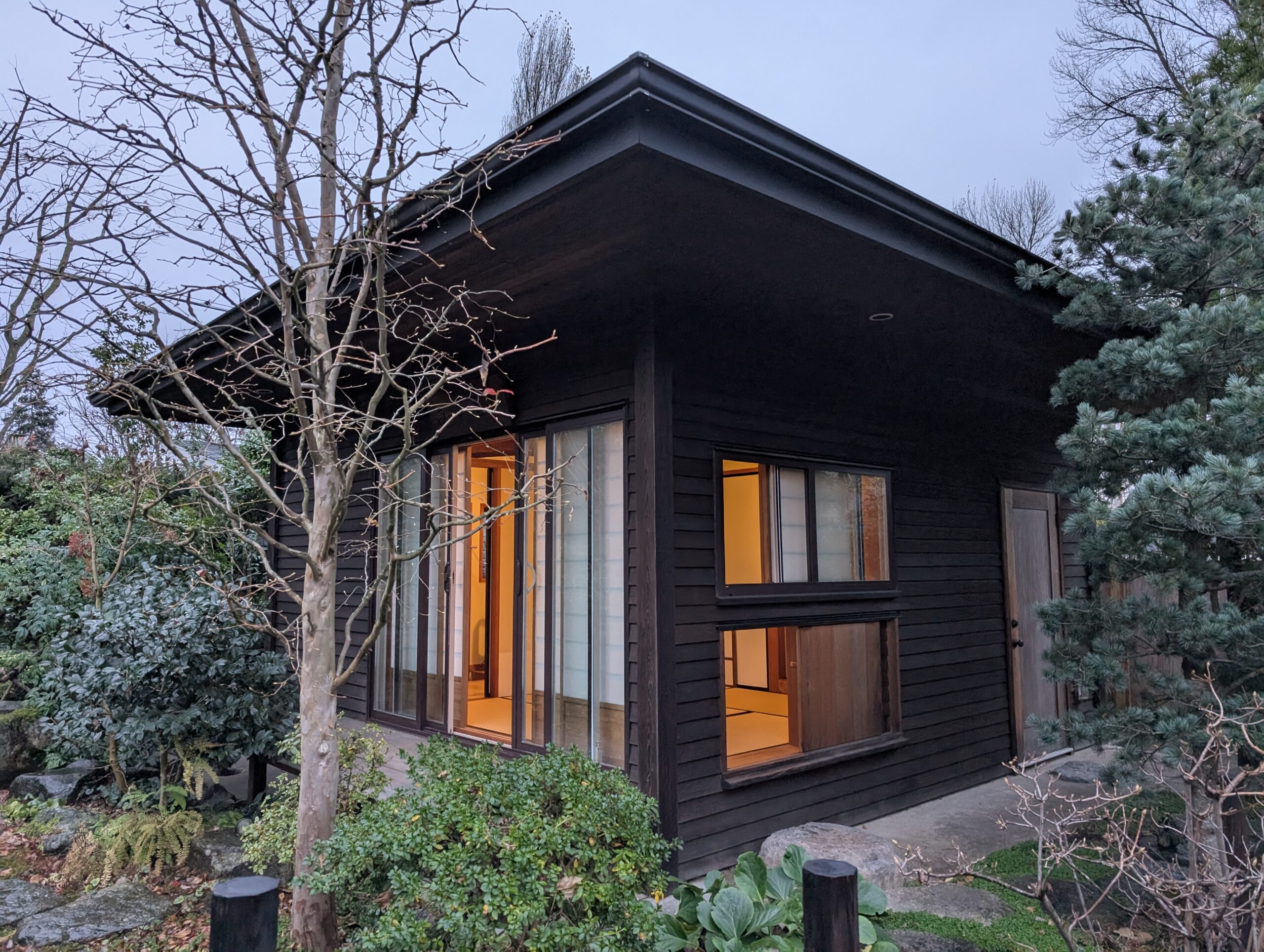“The way you drink is, you pick up the tea bowl with your right hand. Place it on your palm and bring your right hand to the side of the bowl, raise it a little bit, and bow slightly.”
Yasuko Takahashi is coaching me through the proper etiquette to accept and drink a bowl of tea. I’m sitting on tatami mats in a traditional Japanese tea house in her backyard in North Vancouver in late November. She is hosting me for chakai, the less formal, shorter traditional tea ceremony. I say less formal, but this hour-long ceremony still incorporates complex procedures and techniques.
As with the act of accepting the tea, there’s an order to everything. The way the water is boiled. The way each implement used in the tea’s preparation is cleaned, wiped down by her fukusa—an orange cloth that hangs folded from her kimono for much of the ceremony. Even the way the bowl for drinking tea is heated with warm water seemingly follows a particular method. There’s also a set position where I must sit as the guest, as well as where my host sits.

To call it meticulous would be a dramatic understatement. There are over 70 procedures and movements to keep in mind when making tea in this way. For reference, chaji, the more formal tea ceremony, includes a meal and can last up to four hours.
“It’s almost impossible to remember for ordinary people,” she tells me. “And for some very complicated posess , there’s no book so you learn from the teacher.”
Takahashi sensei operates the Hakuhoan Tea Academy out of her home, where she has taught classes and private lessons for around 12 years. She first moved to Vancouver in 1993 from Japan, but she wasn’t a student of tea ceremony back then. Tea ceremony was taught in Japanese high schools and university, but studying it—along with things like flower arrangement—was considered by many to be preparation for a traditional marriage.
“It wasn’t mandatory, but if you’re from a wealthy family, or if you want to marry a high-status gentleman, ladies just learned something like that,” she says, though she notes that isn’t the case anymore.
It wasn’t until she attended an exhibition at the Nitobe Memorial Garden on the University of British Columbia campus that she began to form a new impression of tea ceremony. “I thought, ‘Wow, I misunderstood the Way of Tea,’ because it includes everything. All aspects of Japanese culture,” she says.
After asking around at Nitobe, she found that a Japanese woman who lived nearby was looking for new students, and that was how it started. Almost 30 years later, Takahashi sensei is a teacher herself, practising in the Urasenke tradition, one of the main schools of chado, the Way of Tea . The tradition has rigorous (and expensive) certifications one must achieve to teach, and it takes years of study and practice to attain them.
However, despite achieving a tea name (the intermediate certification needed to be allowed to teach in the Urasenke tradition ), the idea of constructing a tea house came from a personal place rather than an entrepreneurial one. When Takahashi sensei and her family moved to North Vancouver 12 years ago, she noticed that the backyard had room for a garden and even a separate building, and she thought it would work well for continuing her own studies. She hired a local carpenter and gardener to see it through.
Eventually, the word got out about her tea house, and she was approached about the prospect of teaching. Classes started with three students and over the years have grown. She now teaches classes four days a week to students from nine to 82. Weekend classes, private lessons, and lessons on how to make the sweets provided during the ceremony are all available from her home, parts of which pull double-duty as locations for stages of the ceremony.
When I arrive at Hakuhoan, Takahashi sensei leads me to a seating area in her living room. There is an ornate box containing a pipe and space for tobacco as well as charcoal for lighting. People rarely smoke these days, but nonetheless the box is out, positioned to indicate guest order, with a chrysanthemum pattern carved on it to reflect the fall season. Much of the intent behind the initial stage is to let guests relax before things begin in earnest. After a short time in the living room, I am led out to the back yard, to sit on a heavy wooden bench.

Chado is just as much a contemplative and philosophical tradition as it is a procedural one, and this is where it starts: sitting on a bench, staring out at a deliberately arranged garden of trees and shrubs adorned in leaves of green and yellow and red, with stepping stones to guide you toward the tea house at the back of the yard.
Takahashi sensei hesitates to call it a tea garden, but it is constructed in the Japanese style. Even the back wall is constructed in the traditional style, with stones slotted together based on their natural shape, rather than in a uniform fashion. The stepping stones are arranged in a meandering curve, meant to encourage slowly taking in the surroundings. With each step, the path encourages you to abandon the worries beyond the garden and arrive at the tea house with a sense of calm.
After being led around the garden and shown the basin where in warmer months I might have washed my hands and mouth, I am led to the front of the tea house. There is a small sliding door, no higher than waist height, through which I am meant to enter.
Bending down to show humility upon entering the tea house dates back to the tradition’s origins in the 16th century, during Japan’s Sengoku period, a prolonged period of civil war lasting almost two centuries. The idea is that, not matter your class or position, everyone must lower themselves to enter.
Inside the tea house, the floor is covered in thick tatami mats made of woven straw and fabric. The walls are all covered in rice paper. In the centre of the room, a hearth is sunken into the floor, with a large cast iron kettle sitting in it. If this were a chaji, the laying of charcoal would be incorporated into the proceedings, but in today’s chakai, the kettle is heated electrically.
As with many Japanese cultural traditions, the changing seasons are important to the practice of tea ceremony. The time of year dictates which implements to use when making the tea, which containers to hold the matcha powder and water in, where the kettle is situated (it sits in the sunken hearth only from November to April), and what to display in the tokonoma, the alcove to the right of where Takahashi sensei directs me to sit.
Today, the tokonoma holds three objects. To the left, a single camellia bud sits in a small vase. Across from it, a container for incense. And on the back wall hangs a scroll displaying characters for the word “gate” and the four cardinal directions (as well as the name of the monk who initially wrote the calligraphy and the temple he was associated with).
The meaning of the scroll hanging in the tokonoma is something for guests and teachers to contemplate, like a Zen Buddhist koan. For Takahashi sensei, it means “if you keep pushing yourself, you can go in any direction, and the path will be in front of you.”
The tea that is served is matcha, which many people in Vancouver will likely be familiar with already. The powdered green tea, which uses the whole leaf mixed directly into the water, rather than steeping, is a commonplace ingredient in cafés all over. But the tea served here is anything but a retail experience.

After picking up the bowl as coached and turning it clockwise slightly twice so that I don’t drink from its front, I can, finally, drink.
The frothed tea is smooth, its texture almost creamy from the way it is whisked. The flavour is gentle, with an ever-so-slightly bitter herbaciousness that is mediated by the sugary flavour of the tea sweets Takahashi sensei served me moments before. It’s gone in two sips, followed by a final slurp to take in the last of the foam, as is appropriate.
Sen no Rikyū, a Buddhist monk and founder of three schools of tea ceremony (including Urasenke), instilled a focus on four concepts: wa (harmony), kei (respect), sei (purity), and jaku (tranquility). According to Takahashi sensei, these concepts underly everything tea practitioners do.
The pursuit of harmony is reflected in the act of serving another person tea—bringing together the host and guest, the guests with each other, and everyone in attendance with the season. The kei, or respect, is rooted in the act of hosting and being attentive to the needs of the guest, whether they are too warm or too cold, parched or hungry, and so on. Sei, or purity, concerns both the inward and the outward. It relates to the cleanliness of the space (the tea room, the garden, the implements), how the garden and the basin I mentioned earlier help the guest leave the concerns of everyday life outside the tea room, as well as the cultivation of a natural, unforced open-heartedness toward guests. Jaku, or tranquility, relates to the sense of selflessness achieved by putting the other three ideals into practice.
“By learning the Way of Tea, I think I’ve become a better person, and I don’t lose my temper,” she says. “It’s very philosophical. It’s not just making tea.”
Hearing all this, how can I say no when Takahashi sensei offers me another bowl of tea? This second helping comes in a crackle-glazed bowl, the front adorned with an image of Mount Fuji.
I’m already turning the bowl in anticipation of that next sip when she gently reminds me of a handful of steps I had already forgotten. I guess I need more lessons.
Read more tea stories.









